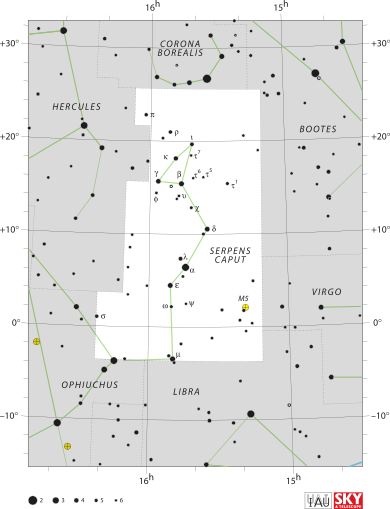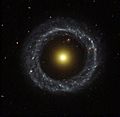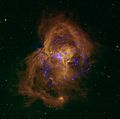Serpens facts for kids
| Constellation | |
  
List of stars in Serpens
|
|
| Abbreviation | Ser |
|---|---|
| Genitive | Serpentis |
| Pronunciation | genitive |
| Symbolism | the Snake |
| Right ascension | Serpens Caput: 15h 10.4m to 16h 22.5m Serpens Cauda: 17h 16.9m to 18h 58.3m |
| Declination | Serpens Caput: 25.66° to -03.72° Serpens Cauda: 06.42° to -16.14° |
| Area | Serpens Caput: 428 sq. deg. Serpens Cauda: 208 sq. deg. Total: 637 sq. deg. (23rd) |
| Main stars | 11 |
| Bayer/Flamsteed stars |
57 |
| Stars with planets | 15 |
| Stars brighter than 3.00m | 1 |
| Stars within 10.00 pc (32.62 ly) | 2 |
| Brightest star | α Ser (Unukalhai) (2.63m) |
| Messier objects | 2 |
| Bordering constellations |
Serpens Caput: Corona Borealis Boötes Virgo Libra Ophiuchus Hercules Serpens Cauda: Aquila Ophiuchus Sagittarius Scutum |
| Visible at latitudes between +80° and −80°. Best visible at 21:00 (9 p.m.) during the month of July. |
|
Serpens is a constellation that means "the Serpent" in Latin. It's found in the northern part of the sky. This constellation is special because it's split into two separate parts.
The first part is called Serpens Caput, which means "Serpent Head." It's located to the west. The second part is Serpens Cauda, meaning "Serpent Tail," and it's to the east. In between these two parts is another constellation called Ophiuchus, the "Serpent-Bearer." It looks like Ophiuchus is holding the snake.
Serpens was first listed by an astronomer named Ptolemy way back in the 2nd century. Today, it's still one of the 88 constellations officially recognized by astronomers around the world.
Contents
Stars and Bright Objects
The brightest star in Serpens is called Alpha Serpentis, also known as Unukalhai. It's a huge red giant star found in Serpens Caput. You can see it with your eyes, and it shines quite brightly.
What's in Serpens Caput?
Besides Unukalhai, Serpens Caput has other cool things to see.
- Messier 5: This is a globular cluster, which is a big, round group of thousands of stars packed closely together. You can even see it without a telescope on a clear night.
- Variable Stars: There are stars like R Serpentis and Tau4 Serpentis that change how bright they appear over time.
- Distant Galaxies:
- Seyfert's Sextet: This is one of the most crowded groups of galaxies known. It's a fascinating sight for astronomers.
- Arp 220: This galaxy is super bright in infrared light. It's a great example of a galaxy where two galaxies are crashing into each other.
- Hoag's Object: This is a very rare type of galaxy called a ring galaxy. It looks like a bright ring of stars around a central core.
What's in Serpens Cauda?
The tail part of Serpens, Serpens Cauda, is special because it's where part of our own Milky Way galaxy passes through. This means it's full of amazing objects in space.
- Eagle Nebula (IC 4703): This huge cloud of gas and dust is where new stars are being born. It's about 70 light-years long and 50 light-years wide.
- Pillars of Creation: Inside the Eagle Nebula, there are three famous dust clouds called the Pillars of Creation. They became very well-known from a stunning picture taken by the Hubble Space Telescope. These pillars are where new stars are forming.
- Red Square Nebula: This is one of the few objects in space that actually looks like a square!
- Westerhout 40: This is a large area where many new stars are forming. It includes a big cloud of gas and dust called a molecular cloud and a glowing region of ionized gas called an H II region.
Images for kids
-
Hoag's Object, a rare ring galaxy found in Serpens.
-
The famous Pillars of Creation in the Eagle Nebula, captured by the Hubble Space Telescope.
See also
 In Spanish: Serpens para niños
In Spanish: Serpens para niños






